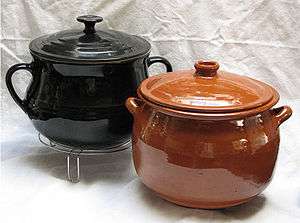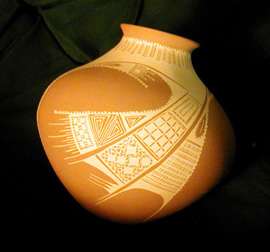Olla
| Look up olla in Wiktionary, the free dictionary. |
An olla is a ceramic jar, often unglazed, used for cooking stews or soups, for the storage of water or dry foods, or for other purposes. Ollas have a short wide neck and a wider belly, resembling beanpots or handis.
History

Antiquity
The Latin word olla or aulla (also aula) meant a very similar type of pot in Ancient Roman pottery, used for cooking and storage as well as a funerary urn to hold the ashes from cremation of bodies. Later, in Celtic Gaul, the olla became a symbol of the god Sucellus, who reigned over agriculture.
Spain
In Spain, the popular dish olla podrida (literally “rotten pot”), cooked in an olla, dates back to the Middle Ages.
Catalonia
In certain areas of the Pyrenees in Catalonia a type of olla, known locally as tupí, is used as container for the preparation of tupí, a certain type of cheese.[1]
American Southwest

The Spanish settlers may have introduced the olla to Native American tribes, but it is likely they had developed a similar shape on their own. They often used unglazed pottery. The olla by its Spanish name has become associated with the region. It was used by settlers and natives both.
Among Southwestern Native American tribes, ollas used for storing water often were made with narrow necks to prevent evaporation in the desert heat. The olla is used by the Kwaaymii people, among many others, for cooking, storing water, serving meals and even nursing infants.[2]
The term olla is also applied to regional basketry shaped with bulbous bodies and narrow necks. Olla baskets are commonly used by the Western Apache, Shoshone, and Yavapai.
Use in irrigation
Because water seeps through the walls of an unglazed olla, these vessels can be used to irrigate plants. The olla is buried in the ground next to the roots of the plant to be irrigated, with the neck of the olla extending above the soil. The olla is filled with water, which gradually seeps into the soil to water the roots of the plant. It is an efficient method, since little water is lost to evaporation or run-off.[3]
This irrigation technique was introduced to the Americas by Spanish settlers in colonial times. Agriculture and gardening specialists are teaching it, and olla use is making a comeback in New Mexico and the American West. The state’s master gardening program is spreading the word. It can be effective for homeowners to use in the desert climate.[3] It has also been put to use by the Global Buckets project.
In their September 2013 newsletter, Ecology Action describes using five 5-gallon ollas for a 100-square-foot garden plot. The test plot is using 1.25 gallons per olla every four days. The ollas are fitted with caps that reduce evaporation and collect rain.
Use in refrigeration
The olla is also useful for keeping water cool. When an unglazed olla is filled with water, the water permeates the clay walls of the vessel, causing the olla to “sweat”. The evaporation of the sweat cools the olla and its contents. In the early 20th century, many ranches in the American Southwest used the practice of hanging an olla from a rope on the verandah in a shady, breezy spot. Several hours after the olla was hung, it was cooled enough by evaporation to keep butter and milk safely cold.[4]
As works of art

In addition to utilitarian purposes, ollas are also produced by Native American and Mexican potters as artistic works. These ollas may be highly decorated and/or formed.
References
- ↑ Formatge de tupí - Ingredients i preparació artesanal
- ↑ "Kwaaymii Culture"
- 1 2 "Spanish colonial olla irrigation makes a comeback", High Plains/Midwest AG Journal, 2015-04-19, accessed 2015-03-14
- ↑ "Ice Water From Sunshine", New York Times, 31 July 1910, accessed 31 Dec 2012